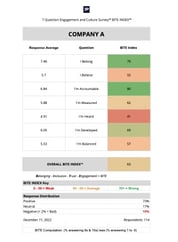In most hiring situations, the first time a candidate comes across the radar of a business is when the job seeker submits a resume to the HR department or HR representative. If the applicant appears to check all of the necessary boxes - an impressive education, and years of employment that indicate how the candidate has acquired experience and demonstrated expertise with the requisite skills - then the applicant is brought in for an interview.
Not surprisingly, this job seeker is on their best behavior during the one-hour interview and sufficiently impresses the HR team to the point where they are assured of success when they offer the applicant the job. Yet, within one week, the brand new employee proves to be a wolf in sheep’s clothing who fails to collaborate effectively with coworkers and openly sews the seeds of discord amongst the staff. Realizing that this employee simply will not fit in with the presently constructed staff, the HR team moves quickly to catalog the misdeeds of the rogue employee in order to commence termination proceedings as quickly as possible, and within the approved guidelines of the company.
This scenario unfolds frequently in workplaces around the world, and hiring for cultural fit has been commonly proposed as a remedy to keep it from happening. The process of hiring employees based on the best cultural fit usually involves the practice of involving several members of the team that the potential new employee would be working alongside in the hiring process. In addition to asking questions designed to ascertain how the new hire might react to common workplace scenarios, team members may also include questions about hobbies, music, pop culture, and politics to see if they will be able to engage in cheerful discussions with the new hire that are not directly connected to work.
While hiring for best cultural fit has its merits, some organizations still manage to miss the mark completely and hire employees who do not match well with the companies in which they are seeking employment. In all likelihood, this is because those organizations have misunderstood the core elements of what hiring for cultural fit should mean.
What it doesn’t mean
Hiring for cultural fit is not based on the premise that all of your employees need to have the same hobbies, religious practices or political affiliations, nor does it mean they all need to have attended the same universities or cheer for the same sports teams. While these commonalities will surely set the stage for employees to engage in some pleasant workplace banter, it also imposes certain artificial constraints upon the staff. Intentionally limiting the diversity of thought amongst team members means fewer new or original ideas can work their way into your organization, which will ultimately put your company at a competitive disadvantage.
Further, it does not mean the people within your organization all need to have the same temperament. Sometimes, situations within the workplace call for assertiveness and forcefulness, and other occasions call for caution and restraint. Ideally, employees would have the situational self-awareness to know when to display each set of characteristics, but many people are simply not wired both ways. With this in mind, it is best not to mandate that all employees have the same disposition, because businesses can pay a steep price in the marketplace if decisions are being driven by folks who don’t know when to take their foot off the gas, or when then are ruled by others who always have their feet on the brakes.
What it should mean
The practice of hiring for the best cultural fit should be based on the degree to which the interviewee’s goals and mission can be aligned with the mission of the company. Provided that the company is in possession of a carefully crafted mission statement, and feels it has been able to receive honest, affirmative answers from the applicant to seven key questions asked by the company, there should be nothing standing in the way of hiring that applicant, provided they also possess the requisite skills to perform the tasks connected with the job.
After hearing an explanation of the company’s mission, how the company conducts its business, and what life will be like for the person who occupies the role the candidate is seeking, the successful candidate would ideally be able to answer “yes” to the following seven questions if they were to accept the role.
- Do I belong?
- Do I believe?
- Would I be accountable?
- Would I be measured well?
- Would I be heard?
- Would I be developed?
- Would I have balance?
Skilled applicants capable of answering “yes” to these seven questions - provided they are being truthful - would meet the truest definition of being a solid cultural fit for your organization, based on their belief in the company’s mission, their adherence to the way the company operates, and their predisposition to loyalty rooted in the belief that the organization will also look out for their professional development and personal well being.
All of the elements presented here are designed to help your company become a Patient Organization by implementing the 7 Question - 7 Promise Framework. Does your company need to adjust its hiring practices and fill itself with skilled employees that are in alignment with the mission of your organization?





